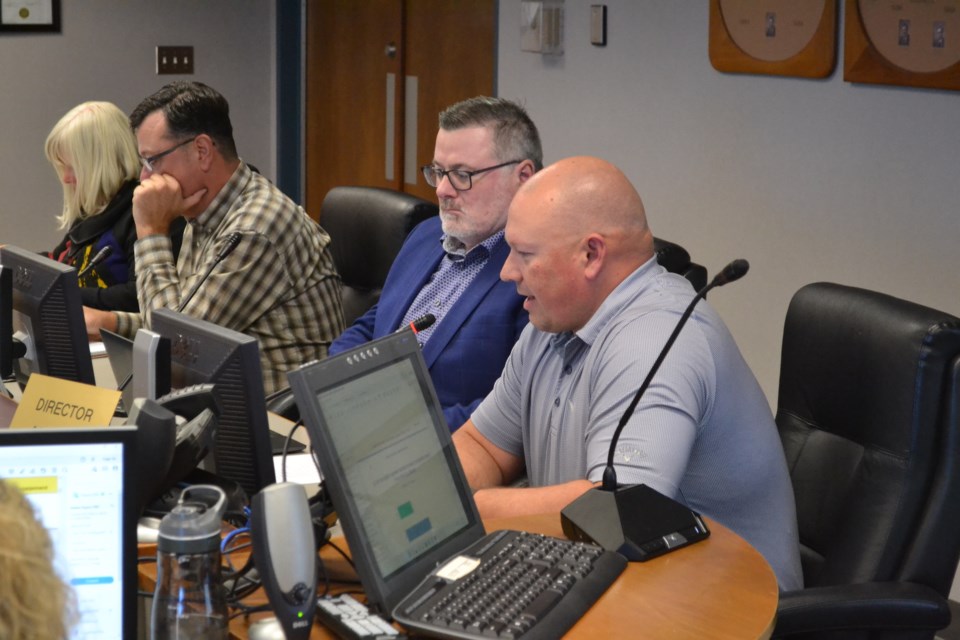OLDS — Nearly 65 per cent of respondents to a town survey are opposed to lowering the residential speed limits in town to 40 kilometres an hour (km/h) from 50 km/h.
Nearly 55 per cent are against greater traffic enforcement by municipal “resources.”
And a slight majority, 56.35 per cent, support converting school zones to playground zones, which would be in force at standardized times year-round.
Those were the results of a survey conducted by the municipality in September and reported to council during its Oct. 11 meeting. Council voted to receive the report as information.
The town’s protective services department will now prepare several options for council to consider during its policies and priorities meeting in November.
Roughly 830 responses were received, both online and in-person.
“This was one of our highest responded-to engagement efforts to date,” reads a portion of a town report.
Protective services director Justin Andrew introduced and commented on the survey questions and responses.
The first question in the survey was the one regarding the possibility of reducing speed limits.
Specifically, it asked "do you support a general reduction of speed in residential streets (from 50 kilometres an hour to 40k)?"
Out of the 829 answers received to that question, 64.78 per cent said no and 35.22 per cent said yes.
“There are other communities around that have gone even further and lowered that to 30,” Andrew said.
Andrew said municipal officials believed that cutting the speed limit to 40 km/h at least to begin with was “more realistic,” after consulting with RCMP.
“They felt that if you go to a 30 kilometres an hour generalized speed, you actually create more problems than you solve, because what happens is that people will feel that it’s way too slow and you start to criminalize everybody, because anyone who breaks the speed limit at 30 then potentially could be getting a ticket,” he said.
The traffic enforcement question asked, “would you support additional municipal resources focused specifically on traffic enforcement?”
The town received 825 responses to that question. A total of 54.79 per cent said no, and 45.21 per cent said yes.
Andrew indicated the idea would be for the municipality to hire staff for that purpose or allocate existing staff to traffic enforcement only, “if that’s something they feel would be a benefit to the community.”
The school zone question asked specifically “do you support the conversion of school zones into playground zones (standardized times year-round)?”
A total of 827 responses were received to this question. Of that number, 56.35 per cent said yes and 43.65 per cent said no.
Andrew gave some context to that question.
He said one example of where that designation could occur is the area around Holy Trinity Catholic School “because it is a playground as well. We do see that when school is out, speeds increase.”
Andrew said another example would be the École Deer Meadow School area, which is not fenced.
He said if those areas became playground zones, posted speed limits would take effect from 8 a.m. to one hour after dark throughout the year.
In contrast, if they remained school zones, those posted speed limits would only be in effect during the school year.
Andrew noted that Craig’s Corner, just off of Highway 27, is one example of a fenced playground. Because it’s fenced, the playground zone rules don’t apply.
He said that’s an Alberta Transportation rule. The idea is that fences control access to sidewalks.
Andrew indicated that converting school zones to playground zones might be easier or less confusing for drivers.
“We don’t have to worry about whether, ‘are the kids in school today? Does that apply? Or during summer vacation?’ It would just be year-round,” he said.
Andrew said the survey did not allow comments because “it’s hard to capture comments and put that into a – I don’t know – an-easy-to-read format at this point.”
He stressed that presentation of the survey results doesn’t necessarily mean the process of obtaining public input on traffic-related questions is over.
“Based on the presentation and the direction from council, we can gather some more data and present some more information.”



